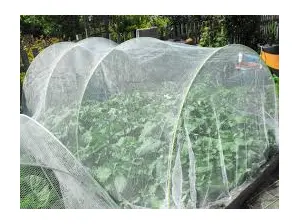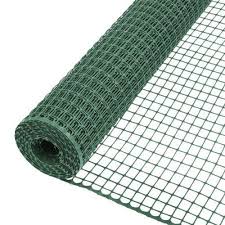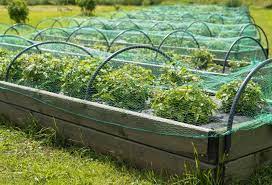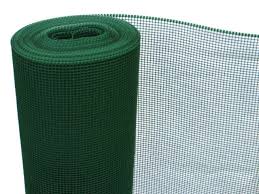The Ultimate Guide to Garden Netting: Protecting Your Plants and Harvest
Garden netting is a versatile tool used in horticulture to protect plants from pests, diseases, and adverse weather conditions. It acts as a physical barrier, preventing access to harmful elements while allowing essential resources like sunlight and water to reach plants. With various types available, including bird netting, insect netting, and shade netting, it's an invaluable asset for any gardener seeking to optimize plant health and yield.
Choosing the Right Type of Garden Netting for Your Plants

Gardening is a labor of love, and any gardener knows the joy of watching plants flourish. However, it's not without its challenges. Pests, birds, and harsh weather can threaten your hard work. This is where garden netting comes to the rescue.
Types of Garden Netting:
Garden netting comes in various types, each designed to serve specific purposes in horticulture.
- Bird Netting:
- Bird netting is designed to protect crops from avian pests. It is made from lightweight, durable materials like polyethylene or nylon. The mesh size is chosen to allow pollinators in while keeping birds out, ensuring the health and productivity of plants.
- Insect Netting:
- Insect netting features a finer mesh size to effectively shield plants from small insects and pests. It is crucial for safeguarding delicate plants, especially during critical growth stages. This type of netting provides a breathable barrier that allows sunlight, air, and water to reach plants while keeping harmful insects at bay.
- Shade Netting:
- Shade netting serves as a protective shield against excessive sunlight. It helps regulate temperature and reduce evaporation in hot climates. Available in varying degrees of shading, shade netting allows gardeners to control the amount of light their plants receive. Additionally, it helps prevent sunscald on sensitive plants, ensuring their health and vitality.
- Deer Netting:
- Deer netting is designed specifically to deter deer and other larger animals from entering a garden or landscape area. It is typically taller and more robust than other types of netting to provide effective protection against browsing wildlife.
- Hail Netting:
- Hail netting is engineered to shield plants from damage caused by hailstones during severe weather events. It features a dense mesh that disperses the force of falling hail, preventing it from causing harm to plants.
- Pond Netting:
- Pond netting is used to protect ponds and water features from debris, leaves, and even birds. It is made from durable materials that can withstand exposure to water and the elements.
- Windbreak Netting:
- Windbreak netting is employed to create a barrier that reduces the impact of strong winds on plants. It helps prevent wind damage and desiccation in windy climates.
- Climbing Plant Netting:
- This type of netting is specifically designed to support and guide the growth of climbing plants, such as peas, beans, and certain ornamental vines. It provides a structure for the plants to cling to as they grow upward.
- Anti-Netting for Pests:
- Some specialized netting varieties are designed to actively deter pests. These may include features like reflective surfaces, tactile deterrents, or other mechanisms to discourage pests from approaching or landing on plants.
The Versatility of Garden Netting: Practical Applications
Garden netting is an incredibly versatile tool that serves a wide range of practical applications in horticulture. Its effectiveness lies in its ability to provide protection and support for plants throughout their growth cycle.
A. Pest Control:
One of the primary purposes of garden netting is pest control. By creating a physical barrier between your crops and potential pests like birds, insects, and rodents, you can significantly reduce the risk of damage and loss. Bird netting, for example, is specifically designed to keep birds from accessing fruits and vegetables, while insect netting with finer mesh sizes effectively shields plants from smaller pests.
B. Disease Prevention:
Garden netting plays a crucial role in preventing the spread of diseases. It acts as a barrier that limits contact between plants, minimizing the chance of infection transmission. This is particularly important in preventing the spread of fungal spores or viruses that can devastate an entire crop.
C. Sun and Heat Protection:
In regions with intense sunlight and high temperatures, garden netting provides essential shade and temperature regulation. This helps prevent heat stress in plants and conserves moisture in the soil. Shade netting is specifically designed to protect plants from excessive sunlight, allowing them to thrive even in hot climates.
D. Hail and Storm Protection:
During severe weather events, garden netting acts as a protective shield against hail, heavy rain, and strong winds. It minimizes physical damage to plants, ensuring their long-term health and productivity. Hail netting, with its dense mesh, disperses the force of falling hailstones, preventing them from causing harm to plants.
E. Supporting Climbing Plants:
Certain types of garden netting, such as climbing plant netting, are designed to provide structural support for climbing plants like peas, beans, and ornamental vines. By creating a framework for these plants to cling to as they grow, the netting helps them reach their full potential.
F. Pond Protection:
Pond netting is used to protect ponds and water features from debris, leaves, and even birds. It is made from durable materials that can withstand exposure to water and the elements, ensuring that your water feature remains clean and free from unwanted debris.
G. Windbreak and Wind Protection:
In windy climates, garden netting can be employed to create a barrier that reduces the impact of strong winds on plants. Windbreak netting helps prevent wind damage and desiccation, allowing plants to thrive even in challenging environmental conditions.
H. Wildlife Deterrence:
Specialized netting varieties, like deer netting, are designed to deter larger animals from entering a garden or landscape area. These nets are typically taller and more robust to provide effective protection against browsing wildlife.
Installing Garden Netting: Best Practices
Proper installation of garden netting is essential to ensure its effectiveness in protecting your plants. Following best practices will not only help safeguard your garden but also extend the lifespan of the netting itself.
A. Proper Sizing and Measurement:
Before you begin the installation process, it's crucial to accurately measure your garden area. This ensures you purchase the correct size of netting that will cover the entire area and provide ample room for plants to grow without being constrained. Take into consideration the height of plants at their mature stage when choosing the netting size.
B. Secure Anchoring:
To effectively protect your plants, ensure the netting is securely anchored to the ground or support structures. This prevents pests from finding gaps or openings to access your garden. Here are some methods for secure anchoring:
- Stakes or Pegs: Use garden stakes or pegs to secure the netting to the ground. Place them at regular intervals along the edges of the netting and drive them into the soil to create a secure perimeter.
- Weights or Rocks: If your garden has a border or rocks, you can use these as weights to hold down the edges of the netting. Ensure they are evenly distributed to maintain a tight seal.
- Support Structures: If your garden has trellises, frames, or other support structures, attach the netting securely to these elements to create a protective barrier around your plants.
C. Provide Adequate Clearance:
Ensure that the netting provides enough clearance for your plants to grow without being restricted. Avoid allowing the netting to rest directly on top of plants, as this can cause damage or hinder their development.
D. Create a Taut Surface:
Stretch the netting as much as possible to create a taut surface. This prevents birds, insects, and other pests from accessing your plants through sagging or loose sections of the netting.
E. Overlap Edges:
If you're using multiple pieces of netting to cover a larger area, be sure to overlap the edges. This helps create a seamless barrier and prevents pests from finding gaps between pieces.
F. Monitor and Adjust:
Periodically inspect your garden netting for any signs of wear, tears, or damage. Promptly repair or replace any compromised sections to maintain the effectiveness of the netting in safeguarding your plants.
G. Consider Netting Accessories:
Depending on your specific needs, consider using accessories like net clips or ties to secure the netting in place. These can provide additional support and ensure the netting remains in position even in adverse weather conditions.
Benefits of Garden Netting:
Garden netting offers a wide range of benefits for gardeners, making it an invaluable tool in horticulture.
- Pest and Wildlife Control:
- Garden netting creates a physical barrier that effectively prevents pests, birds, insects, and larger wildlife from accessing and damaging plants. This protection is crucial for preserving the health and productivity of crops.
- Disease Prevention:
- By acting as a barrier, garden netting helps limit physical contact between plants, reducing the risk of disease transmission. This is especially important in preventing the spread of fungal spores, viruses, and other pathogens.
- Protection from Adverse Weather Conditions:
- Garden netting provides a protective shield against severe weather events, including hail, heavy rain, and strong winds. It minimizes physical damage to plants, ensuring their long-term health and productivity.
- Sun and Heat Regulation:
- Shade netting helps regulate temperature and reduce evaporation in hot climates. By providing essential shade, it prevents heat stress in plants and conserves moisture in the soil.
- Support for Climbing Plants:
- Certain types of netting, such as climbing plant netting, offer structural support for climbing plants like peas, beans, and ornamental vines. This allows them to grow upward and reach their full potential.
- Reduction of Wind Damage:
- In windy climates, garden netting acts as a windbreak, reducing the impact of strong winds on plants. This helps prevent wind damage and desiccation, allowing plants to thrive even in challenging environmental conditions.
- Improved Crop Yield:
- By protecting plants from pests, diseases, and adverse weather conditions, garden netting ultimately leads to higher crop yields. This is particularly important for commercial growers and those aiming to maximize their harvest.
- Extended Growing Seasons:
- Garden netting can help extend the growing season by providing a controlled environment. It offers protection against early or late frosts, allowing gardeners to start planting earlier in the spring and continue growing later into the fall.
- Reduced Chemical Use:
- By providing a physical barrier against pests and diseases, garden netting can reduce the need for chemical pesticides and fungicides. This promotes a more eco-friendly and sustainable approach to gardening.
- Preservation of Beneficial Insects:
- Fine-mesh insect netting allows beneficial insects like pollinators to access plants while keeping harmful pests out. This supports a healthy and balanced ecosystem within the garden.
- Customized Shading and Light Control:
- Shade netting allows gardeners to control the amount of light their plants receive. This is especially important for light-sensitive plants or in regions with intense sunlight.
- Improved Aesthetic Appeal:
- Garden netting can be designed to blend seamlessly with the garden's overall aesthetic, enhancing its visual appeal while still providing essential protection.
Choosing the Right Garden Netting:
Choosing the right garden netting is essential for effectively protecting your plants and maximizing their growth potential.
1. Identify Your Garden's Needs:
Before choosing a specific type of garden netting, assess the specific needs of your garden. Determine what you need protection from - whether it's birds, insects, larger wildlife, or adverse weather conditions.
2. Understand the Different Types of Garden Netting:
Familiarize yourself with the various types of garden netting available and their specific purposes. For example, bird netting is designed to deter birds, while insect netting is crafted with finer mesh sizes to protect against smaller pests.
3. Consider Mesh Size:
The mesh size of the netting is crucial. It should be large enough to allow beneficial insects like pollinators to access plants while keeping pests out. However, it should also be small enough to effectively deter the specific pests you are targeting.
4. Material and Durability:
Choose netting made from durable materials like polyethylene or nylon, which can withstand outdoor conditions. Ensure the material is UV-resistant to prevent degradation from prolonged sun exposure.
5. Size and Coverage Area:
Measure your garden area to determine the size of netting you need. Consider both the length and width to ensure complete coverage. It's better to have slightly more netting than needed, as excess can be trimmed.
6. Consider the Environmental Impact:
opt for eco-friendly and sustainable options whenever possible. Look for netting made from recycled materials or those that can be recycled after use.
7. Evaluate the Climate:
Consider the climate in your area. If you experience extreme weather conditions like heavy rain, hail, or strong winds, choose netting that offers the appropriate level of protection.
8. Ease of Installation:
Choose netting that is easy to install and secure. Look for features like reinforced edges, grommets, or built-in ties that make installation straightforward.
9. Flexibility and Versatility:
Some types of netting are more versatile and can be used for various applications. Consider whether you might want to use the netting for different purposes in the future.
10. Budget Considerations:
Set a budget for your garden netting and look for options that offer a good balance between cost and quality. Remember that investing in high-quality netting can lead to longer-lasting protection for your plants.
11. Read Reviews and Seek Recommendations:
Read customer reviews and seek recommendations from other gardeners. They can provide valuable insights into the performance and durability of specific netting products.
Maintenance
Maintaining garden netting is crucial to ensure its effectiveness in protecting your plants. Regular upkeep and proactive care can extend the lifespan of the netting, saving you time and money in the long run.
1. Regular Inspections:
Conduct regular inspections of the garden netting to check for any signs of wear, tears, or damage. Inspect the entire surface, paying close attention to edges, corners, and areas where the netting may be in contact with plants or support structures.
2. Prompt Repairs:
If you discover any tears, holes, or damage during your inspections, make prompt repairs. Use patch kits or repair tapes specifically designed for garden netting. This will prevent further damage and ensure the netting continues to provide effective protection.
3. Cleaning:
Clean the netting periodically to remove dirt, debris, and any organic matter that may have accumulated. Use a gentle brush or hose to gently wash away dirt and grime. Avoid using harsh chemicals or abrasive cleaning agents, as they can damage the netting material.
4. Remove Excess Weight:
If the netting has accumulated leaves, debris, or excess moisture, remove it to prevent sagging. Excess weight can strain the netting and compromise its effectiveness.
5. Adjustments for Growth:
As your plants grow, they may come into contact with the netting. Adjust the netting to provide adequate clearance and prevent it from pressing against the plants. This will help avoid damage and ensure healthy growth.
6. Secure Anchoring:
Periodically check that the netting is securely anchored to the ground or support structures. Ensure that stakes, pegs, or weights are in place and that the netting is taut. Re-secure any areas that may have become loose.
7. Store Properly:
If you remove the netting during certain seasons, store it properly to prevent damage. Roll or fold the netting neatly and store it in a dry, cool place away from direct sunlight. Avoid placing heavy objects on top of stored netting.
8. Replace When Necessary:
If the netting has become severely damaged or worn over time, consider replacing it with a new piece. Continuing to use compromised netting may not provide the level of protection your plants need.
9. Consider Seasonal Changes:
Depending on your location and climate, you may need to adjust or change the type of netting used to accommodate seasonal changes in pest activity or weather conditions.
10. Keep Records:
Maintain a record of when you installed the netting and any maintenance or repairs you have performed. This can help you track the netting's lifespan and plan for future replacements.
Garden netting is a valuable asset for any gardener, providing essential protection and support for plants throughout their growth cycle. By understanding the various types of garden netting and their applications, you can make informed choices to enhance the health and productivity of your garden. Remember to follow best practices for installation and maintenance to ensure the longevity and effectiveness of your garden netting.






